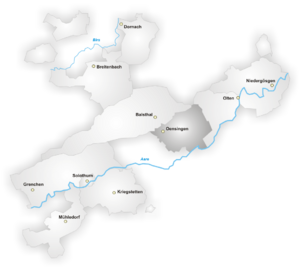Gäu District facts for kids
The Gäu District is one of ten important areas, called districts, in the Solothurn canton in Switzerland. It's located right in the middle of the canton. As of 31 December 2020, about 22,005 people live here. The Gäu District also teams up with the Thal District to form a larger voting area called Thal-Gäu.
Contents
What are the Towns in Gäu District?
The Gäu District is made up of several towns, which are called municipalities. Here’s a list of them:
| Coat of arms | Municipality | Population (31 December 2020) |
Area, km² |
|---|---|---|---|
| Egerkingen | 4,041 | 6.93 | |
| Härkingen | 1,644 | 5.57 | |
| Kestenholz | 1,848 | 8.59 | |
| Neuendorf | 2,277 | 7.13 | |
| Niederbuchsiten | 1,260 | 5.49 | |
| Oberbuchsiten | 2,296 | 9.39 | |
| Oensingen | 6,276 | 12.03 | |
| Wolfwil | 2,363 | 6.89 | |
| Total | 22,005 | 62.02 |
What is the Geography of Gäu District Like?
Gäu District covers an area of about 62 square kilometers (24 square miles). A big part of this land, almost half (44.7%), is used for farming. Forests cover a large section too, about 37.7% of the district.
The remaining land is where people live and work. About 16.8% of the area has buildings and roads. A small part, 0.7%, is made up of rivers or lakes. Very little land (0.1%) is unproductive, meaning it cannot be used for anything.
What is the Coat of Arms for Gäu District?
The official symbol, or blazon, for the Gäu District's coat of arms is described as "Tierced per fess Gules Argent and Sable." This means it has three horizontal stripes. The top stripe is red (Gules), the middle stripe is silver or white (Argent), and the bottom stripe is black (Sable).
Who Lives in Gäu District?
The Gäu District has a population of 22,005 people as of December 2020. Most people in the district speak German, which is about 90.3% of the population. Other languages spoken include Albanian (2.1%) and Serbo-Croatian (1.8%).
In 2008, about 50.5% of the people living in Gäu were male and 49.5% were female. Many people were born in Gäu (36.4%) or elsewhere in the same canton (23.7%). About 22.7% were born in other parts of Switzerland, and 14.0% were born outside of Switzerland.
The population of Gäu District has grown over time. You can see how the number of people has changed in the chart below:

How Does Politics Work in Gäu District?
In the 2007 national election, the most popular political group in Gäu District was the SVP. They received about 29.77% of all the votes. Other popular parties were the CVP (29.24%), the FDP (23.3%), and the SP (11.06%). More than half of the people who could vote, about 52.5%, participated in this election.
What Religions are Practiced in Gäu District?
Based on information from the year 2000, many people in Gäu District are Roman Catholic, making up about 56.3% of the population. Another large group, about 22.0%, belongs to the Swiss Reformed Church.
There are also smaller groups of other religions. About 5.86% of the population is Islamic. Some people follow Buddhism (62 individuals) or Hinduism (34 individuals). A number of people (9.33%) do not belong to any church or religion.
What About Education in Gäu District?
Education is important in Gäu. About 39.2% of the people have finished high school, which is called non-mandatory upper secondary education in Switzerland. Also, about 8.9% have gone on to higher education, like a university or a specialized college (a Fachhochschule).
During the 2010-2011 school year, there were 451 students in the Gäu school system. In the Canton of Solothurn, children usually go to primary school for six years. After that, they go to secondary school for three required years, followed by three to five years of optional advanced schooling. In Gäu District, 430 students were attending lower secondary school at that time.
See also
 In Spanish: Distrito de Gäu para niños
In Spanish: Distrito de Gäu para niños



